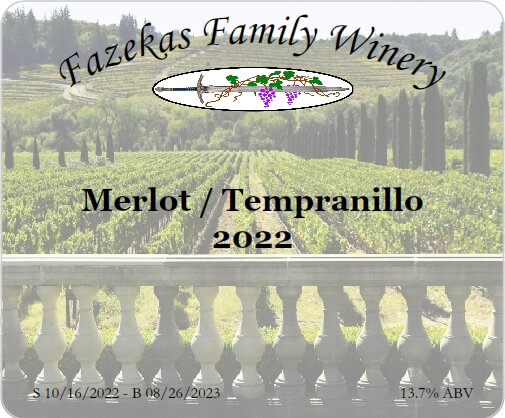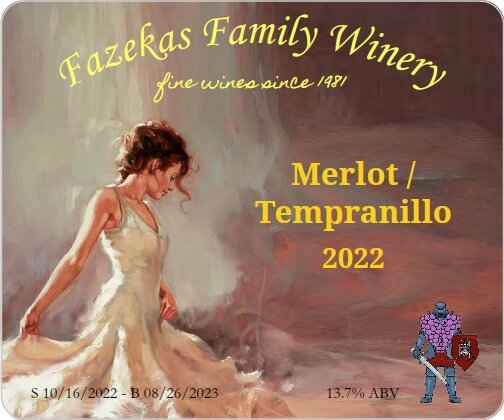2022 Merlot / Tempranillo
October 2022
We are trying 2 experiments of the same type this fall. Our main batches are 8 lugs each Grenache and Tempranillo. We took the pomace from each and added to it a Finer Wine Kits Tavola Merlot kit. The intention is to see how much the pomace affects the Merlot, and how different the two resulting wines are from each other


Ingredients
| Fruit | Finer Wine Kits Tavola Merlot kit pomace from 8 lugs (288 lbs) Tempranillo |
| Nutrient | 7 tsp Fermax, split |
| Yeast | Lalvin RC-212 and Renaissance Avante that is in pomace |
| Fermentation Oak | oak remaining in pomace |
| Fining Agents | kieselsol and chitosan (from kit) |
| Aging Oak | 1 oz medium toast Hungarian oak cubes |
| K-meta | as needed |
| Glycerin | 8 oz |
Method
| Reconstituted the kit to 23 liters. We decided to completely skip the additives in the kit, as the addition of Tempranillo pomace changes the situation so much.
The Tempranillo had 8 cups of medium toast American shredded oak and 3 tsp ScottZyme ColorPro added, so we added nothing other than 5 tsp Fermax. The pomace from 288 lbs of grapes in a LOT, and 6 gallons of must didn’t break it up much. Stirring this will be an effort. Added no yeast as the pomace is full of yeast. The SG listed is the SG of the kit before mixing. When calculating the ABV, we’ll use that to calculate the expected ABV of the Merlot kit, and average that with the ABV of the Grenache. The result should be accurate enough. |
10/16/2022 SG 1.100 |
| Fermentation took off immediately — I could smell fresh fermentation within 3 hours of the original mixing (10/16). Stirring is difficult as the must is so thick, but slighter easier than the Merlot/Grenache.
Added 2 tsp Fermax. |
10/18/2022 SG — |
| Both of the kit/pomace wines fermented FAST. They were done by Thursday night, so we pressed on Friday.
Used my new pH meter and got 3.84, which is a bit high. I’ll probably add a bit of acid after the next racking (I add acid incrementally to avoid over-doing it). Added kieselsol and chitosan. |
10/21/2022 SG 0.999 |
| Racked and homogenized the containers. Added 1/2 tsp K-meta. Racked back into 23 liter carboy plus smaller containers. Added 1 oz oak cube to the 23 liter carboy. | 11/05/2022 SG 0.999 |
| Realized I haven’t added K-meta recently, so added 1/4 tsp to the carboy. Made solution of 6 Tbsp water with 1/4 tsp K-meta, and added 1 Tbsp to each 4 liter jug. | 04/07/2023 SG 0.999 |
| Today is bottling day. We racked the 23 liter carboy into a primary. Upon tasting, it’s acidic. I normally add a maximum of 1 oz glycerin per gallon, but went with 8 oz in a project 7 gallon batch, to curb the acid. Taste testing proved that it helped — the wine is still a bit acidic, but better. Added a heaping 1/4 tsp K-meta.
The remaining 4 liter jug was mislabeled — it’s Merlot/Grenache. We decided it wasn’t worth dealing with, so we added it to the main batch, which improved it. Bottled. |
08/26/2023 SG 0.999 |
Notes
| Yield | 36 bottles |
| Alcohol | 13.7% ABV |
| At bottling | This one is a bit harsh now, but has all indications of being a longer aging wine. I will not be surprised to get 8, maybe 10 years out of it. |
| 04/22/2024 | As is my habit, I poured unaerated and aerated glasses:
Unaerated: The color is “right” for a medium-to-heavy bodied red; translucent, unlike the 2020 Meritage which is totally opaque. The wine smells like Merlot. Unfortunately, the taste is flat. It’s not bad, just not exciting. This is 6 gallons Merlot/Tempranillo with 1 gallon Merlot/Grenache, and surprisingly enough, the Grenache stands out. Aerated: Aeration makes the wine much brighter, with stronger fruit notes, almost a strawberry flavor which is probably from the Grenache. I’ve made a couple of Tavola kits without skin packs — this one is richer so the addition of pomace was worth it. There is a hint of oak in the background, but little tannin. Folks that like tannin might be disappointed; I’d serve this to folks that are not heavy red drinkers. It’s got enough acid to be a good steak wine, and I’d serve it with milder cheeses. |
| 08/19/2024 | This is the last bottle of the case. It’s my least favorite of the wines made in Fall 2022, so I’ve been using it up while allowing others to mature. Note that “least favorite” doesn’t mean it’s a bad one; just that I like the others better.
Unaerated: The color as the wine goes into the glass is a bright, shimmering purple; something of a surprise. The strawberry note I previously commented on is there, stronger than it was before. This is really surprising as Merlot and Tempranillo do not have that characteristic, yet this wine which is 1/6 Merlot/Grenache vs the 5/6 Merlot/Tempranillo, has it. Aerated: As expected, the aeration improves the wine a lot. The strawberry stands out and the slight acid bite I noticed in the unaerated aftertaste is gone. I wish I had added more tannin to this one — it’s good but lacking just a bit. That said, I’d have no problem serving this as it came out good. Note that I’m obviously over-critical of my own wines. |
